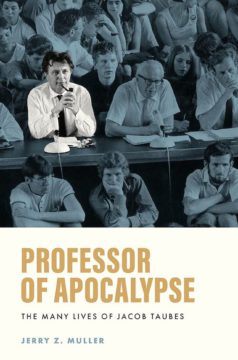by David J. Lobina

As I mentioned last month, the first thing one notes when approaching Rudolf Rocker’s 1937 book, Nationalism and Culture, is its impressive combination of breadth and depth, thus making it entirely unpublishable today. Not only that, and what’s worse, the book is also rather modern in outlook as well as original. The originality stems from Rocker’s interest in the practical effects of nationalism on the people that have to undergo the typical processes of becoming a “common people” (not something historians care much about), whilst the relevance of the overall account follows from the prescience of some of the ideas defended in the book.
The book itself is divided into two parts and spans nearly 600 pages. Book I traces the evolution of nationalism and its relationship to the expansion of the state, resulting in the reality of the nation-state, while Book II is a critical analysis of the notion that there is any type of homogeneity to any one national identity or nation. Remarkably, Book I anticipates some features of the modern study on nationalism, and something along these lines is also true of Book II vis-à-vis “the linguistic update of nationalism” I offered so long ago now, with the required modifications and adjustments. So let us deep-dive, as the nerds say nowadays.[i] Read more »

 In the middle 1990’s along with journal-editing I did another job in Berkeley which was even more arduous, but also in some ways quite exciting and instructive. I was invited by the campus academic senate to serve for 3 years in a high-powered committee that decided on all appointments, promotions, salaries and merit payment increases for all Berkeley faculty (then roughly about 2,000 in size). This committee is called the Budget Committee in Berkeley; technically it advises the Chancellor, but the latter took our advice in 99% of cases—in the less than 1% cases when the Chancellor did not follow our advice, the rule was that the Chancellor was obliged to meet us in a special session of the committee and explain why he/she would not follow our advice (most often this involved some legal issues) and we had a chance to rebut their arguments.
In the middle 1990’s along with journal-editing I did another job in Berkeley which was even more arduous, but also in some ways quite exciting and instructive. I was invited by the campus academic senate to serve for 3 years in a high-powered committee that decided on all appointments, promotions, salaries and merit payment increases for all Berkeley faculty (then roughly about 2,000 in size). This committee is called the Budget Committee in Berkeley; technically it advises the Chancellor, but the latter took our advice in 99% of cases—in the less than 1% cases when the Chancellor did not follow our advice, the rule was that the Chancellor was obliged to meet us in a special session of the committee and explain why he/she would not follow our advice (most often this involved some legal issues) and we had a chance to rebut their arguments. With the US Supreme Court’s recent decision to overturn Roe v. Wade, the decades-long dialogue des sourds concerning the moral status of foetuses has attained new heights of futility. Some who regret the decision have adapted the “trust the science” piety lately honed in an epidemiological context to return to what they take to be a settled embryological fact: that there is no good scientific basis for the presumption that an early-term foetus is a suitable candidate for moral personhood, since its level of neurophysiological development is insufficient to warrant any attribution to it of a capacity to feel pain. This presupposes however that personhood is won by candidates for it through an investigation of their physical constitution, and that it can be directly “read off of” the arrangement of their parts and the capacities known to depend on that arrangement.
With the US Supreme Court’s recent decision to overturn Roe v. Wade, the decades-long dialogue des sourds concerning the moral status of foetuses has attained new heights of futility. Some who regret the decision have adapted the “trust the science” piety lately honed in an epidemiological context to return to what they take to be a settled embryological fact: that there is no good scientific basis for the presumption that an early-term foetus is a suitable candidate for moral personhood, since its level of neurophysiological development is insufficient to warrant any attribution to it of a capacity to feel pain. This presupposes however that personhood is won by candidates for it through an investigation of their physical constitution, and that it can be directly “read off of” the arrangement of their parts and the capacities known to depend on that arrangement. Last year, an experiment suggested that the elementary particle had inexplicably strong magnetism, possibly breaking a decades-long streak of victories for the leading theory of particle physics, known as the standard model. Now, revised calculations by several groups suggest that the theory’s prediction of muon magnetism might not be too far away from the experimental measurements after all.
Last year, an experiment suggested that the elementary particle had inexplicably strong magnetism, possibly breaking a decades-long streak of victories for the leading theory of particle physics, known as the standard model. Now, revised calculations by several groups suggest that the theory’s prediction of muon magnetism might not be too far away from the experimental measurements after all. The misleadingly presented climate pledges coming out of Davos are but one act in a much larger, intricately choreographed ballet of baloney about carbon removal. The Intergovernmental Panel on Climate Change, for instance, has proposed several climate scenarios that could potentially limit global warming to the target of 1.5 degree Celsius, but every one of them assumes that vast amounts of carbon — between
The misleadingly presented climate pledges coming out of Davos are but one act in a much larger, intricately choreographed ballet of baloney about carbon removal. The Intergovernmental Panel on Climate Change, for instance, has proposed several climate scenarios that could potentially limit global warming to the target of 1.5 degree Celsius, but every one of them assumes that vast amounts of carbon — between  Every woman should have the legal right safely to terminate a pregnancy that she does not wish to continue, at least until the very late stage of pregnancy when the fetus may be sufficiently developed to feel pain. That has been my firm view since I began thinking about the topic as an undergraduate in the 1960s. None of the extensive reading, writing, and debating I have subsequently done on the topic has given me sufficient reason to change my mind.
Every woman should have the legal right safely to terminate a pregnancy that she does not wish to continue, at least until the very late stage of pregnancy when the fetus may be sufficiently developed to feel pain. That has been my firm view since I began thinking about the topic as an undergraduate in the 1960s. None of the extensive reading, writing, and debating I have subsequently done on the topic has given me sufficient reason to change my mind. When drafting legislation, vocabulary counts for everything. Opposing viewpoints were passionately aired over seemingly minute details. Within this group, there were two sides: One believes that death is best described as permanent, and the other believes death is irreversible. The distinction is subtle, but critical. Fans of the latter definition argue that describing death as “permanent” doesn’t go far enough—death is only permanent if no medical action is taken, but irreversible means that nothing can be done. A North Dakota doctor by the name of Christopher DeCock, who opted for the bridge of the original Starship Enterprise as his background, used another fantasy tale to make his fandom of Team Irreversible known. “This isn’t Princess Bride, where you’re mostly dead,” he says, paraphrasing Billy Crystal’s comedic relief healer Miracle Max from the 1987 classic. “Either you’re dead or you’re not dead.”
When drafting legislation, vocabulary counts for everything. Opposing viewpoints were passionately aired over seemingly minute details. Within this group, there were two sides: One believes that death is best described as permanent, and the other believes death is irreversible. The distinction is subtle, but critical. Fans of the latter definition argue that describing death as “permanent” doesn’t go far enough—death is only permanent if no medical action is taken, but irreversible means that nothing can be done. A North Dakota doctor by the name of Christopher DeCock, who opted for the bridge of the original Starship Enterprise as his background, used another fantasy tale to make his fandom of Team Irreversible known. “This isn’t Princess Bride, where you’re mostly dead,” he says, paraphrasing Billy Crystal’s comedic relief healer Miracle Max from the 1987 classic. “Either you’re dead or you’re not dead.” It may be time
It may be time Leonard Benardo in Dissent:
Leonard Benardo in Dissent: Raymond Geuss in The New Statesman:
Raymond Geuss in The New Statesman: Jewellord T. Nem Singh in Phenomenal World:
Jewellord T. Nem Singh in Phenomenal World: MANY READERS OF LARB and other literary journals may very well never even have heard the name — let alone be aware of the thought and personality — of the idiosyncratic philosopher and religious thinker Jacob Taubes (1923–1987). Why, then, would the distinguished intellectual historian Jerry Z. Muller dedicate many years to writing a highly detailed, nuanced biography of this apparently obscure figure? It would be sufficient to show that, in the second half of the 20th century, Taubes was an immensely well-connected and putatively brilliant man, an exotic, animating presence in the Western intellectual firmament, restlessly traversing Europe, the United States, and Israel. But what gives this study its special flavor is the fascinating, quasi-erotic, well-nigh demonic nature of the man’s personality and Muller’s tantalizing connection of these features to Taubes’s philosophical ruminations and religious and historical pursuits. Given his intensity and radicalism, his wildly vacillating moods and relationships, his unending contempt for cozy and settled bourgeois liberalism, and his search for some kind of messianic universal future, the title Muller has chosen for his biography, Professor of Apocalypse: The Many Lives of Jacob Taubes, could not be more apt.
MANY READERS OF LARB and other literary journals may very well never even have heard the name — let alone be aware of the thought and personality — of the idiosyncratic philosopher and religious thinker Jacob Taubes (1923–1987). Why, then, would the distinguished intellectual historian Jerry Z. Muller dedicate many years to writing a highly detailed, nuanced biography of this apparently obscure figure? It would be sufficient to show that, in the second half of the 20th century, Taubes was an immensely well-connected and putatively brilliant man, an exotic, animating presence in the Western intellectual firmament, restlessly traversing Europe, the United States, and Israel. But what gives this study its special flavor is the fascinating, quasi-erotic, well-nigh demonic nature of the man’s personality and Muller’s tantalizing connection of these features to Taubes’s philosophical ruminations and religious and historical pursuits. Given his intensity and radicalism, his wildly vacillating moods and relationships, his unending contempt for cozy and settled bourgeois liberalism, and his search for some kind of messianic universal future, the title Muller has chosen for his biography, Professor of Apocalypse: The Many Lives of Jacob Taubes, could not be more apt. What linked these loosely connected scholars, the book suggests, was their interest in using the study of exotic cultures to illuminate the peculiarities of the “civilised” world. As Malinowski put it, “in grasping the essential outlook of others, with reverence and real understanding, due even to savages, we cannot help widening our own”.
What linked these loosely connected scholars, the book suggests, was their interest in using the study of exotic cultures to illuminate the peculiarities of the “civilised” world. As Malinowski put it, “in grasping the essential outlook of others, with reverence and real understanding, due even to savages, we cannot help widening our own”.  THE SUMMERS ARE ALWAYS HOT
THE SUMMERS ARE ALWAYS HOT